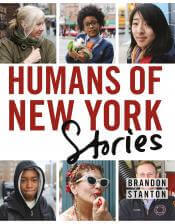The Psychology of Why You Love Humans of New York
Ellen Hendriksen, PhD, explains the psychology behind how Humans of New York has garnered millions of fans.
Ellen Hendriksen, PhD
I recently interviewed Humans of New York creator, photographer, and interviewer Brandon Stanton. Check out our conversation here.
Our conversation got me thinking about why people love HONY so much. In the comments section of the HONY blog or social media pages, you’ll often see people write “I do this, too!” or “I relate to her a lot” or most simply, “ME.” I think HONY offers many things—empathy, validation—but the biggest thing I think people get out of it is normalization.
If a random stranger shown on HONY does or thinks something you thought you were alone in doing or thinking, it breaks the grip of “I’m the only one.” Even just two is infinitely more powerful than one. You’re not alone anymore. And, if there are two, there might just be more, which—slowly but truly—inches toward full-blown community.
Think of the famous conformity experiments from, appropriately, the 1950s. Psychologist Solomon Asch gathered a group of seven confederates and one unsuspecting subject in a room, where they were shown a card with a line drawn on it. Then they were shown another card with three different lines—a, b, and c—and were asked to identify which of the three lines matched the length of the line from the first card. When, as planned, the confederates all gave the same wrong answer, our subject, after a lot of double-takes and obvious discomfort, would also give the wrong answer fully 75% of the time, even though it defied every part of his experience. The kicker? When even one of the seven confederates gave the right answer, the subject almost always breathed a sigh of relief and gave the right answer, too. One alone risks looking like an idiot, but two can stand as a team.
HONY has the same effect: when someone else—especially someone willing to be seen by millions of HONY followers later that day—shares your experience, it sweeps away any hidden shame and secrecy. So thank the brave souls of HONY for normalizing all the vulnerabilities in your life you preferred to keep under your rug. Chances are you’re perfectly normal after all.
Here are three HONY portraits that are honest and authentic for each individual, but share sentiments that garner “Me too!” from untold others. Maybe you’ll see yourself in their faces and stories.
I love this woman’s honesty and bravery. Her thinking is super common, especially among women. Here’s how it usually goes: we assume that if friends saw who we “really” are, they’d hightail it out the door and we’d be left alone and rejected. We also assume that if we’re not serving our friends by being the entertainer or the helper, we’d be rejected.
But it’s a double standard. And it actually does a disservice to a friend to assume they are so fragile that they wouldn’t be able to handle any of our struggles, or that they’re so selfish or mean that they wouldn’t want to. (Plus, if a friend does, in fact, only sign on for the good times, it’s questionable if that person is a true or worthy friend.)
In a true and healthy friendship, disclosure is reciprocal. This equality keeps each person on the same level—eye to eye, as it were, not one looking down on the other. And interestingly, disclosure has the secret effect of making someone feel closer to us and vice versa. We worry that disclosure will leave us adrift, when in fact it brings us closer.
See Also: Humans of New York’s Brandon Stanton on How to Talk to Strangers
People often end up replicating a difficult relationship in their life—it’s so common for kids of abusive parents to marry an abusive partner, or for others to jump from one unhealthy relationship to another. For some, it can feel like a chance to try again—a hope that things will be different this time. For others, it can be a sense of consistency—if a relationship feels familiar, it often feels right and normal, even though it costs us tremendously. But the happy ending to his story, as well as the look of hard-earned confidence on his face, just makes me want to give this man a high-five.
This veteran nails the ability to hold a “both-and” mindset. He can hold two incompatible thoughts simultaneously, and allow them both be true. It’s the opposite of either-or, which sets things up as an (often) false dichotomy. Don’t get me wrong, there are true either-or situations (the criminal justice system, for example, isn’t known for wiggle room between guilty or not guilty), but in general, being able to see that a situation can be black AND white can be freeing. Without getting into Buddhist territory or quantum physics, suffice it to say this gentleman’s ability to make peace with both his truths is far more powerful than denying one in service of the other.
Do you read Humans of New York? Are the photos and captions moving to you? Do you find they help you feel less alone? Let me know on my Savvy Psychologist Facebook page. I’d love to hear from you.

And don’t forget to listen to my full episode with HONY’s Brandon Stanton, in which we discuss how to talk to strangers and the importance of empathy, on iTunes and Stitcher. Or you can simply read the transcript here.
You can purchase a copy of Humans of New York: Stories on Amazon, Barnes & Noble, IndieBound, Books-a-Million, or Apple.
This content is strictly for informational purposes and doesn’t substitute for mental health care from a licensed professional.

